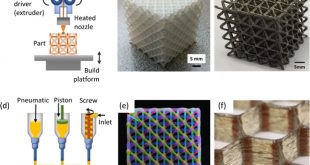Introduction In a world where renewable energy sources are becoming increasingly important, scientists have unveiled a groundbreaking technology that has the potential to transform the renewable energy landscape. Air-gen, a revolutionary invention capable of harnessing electricity from air humidity using almost any material, opens up new possibilities for clean and …
Read More »Unlocking the Potential: Exploring the Power of Ferroelectric Nanomaterials for Smaller, More Efficient Electronic Devices
Nanomaterials have emerged as a groundbreaking field of study, unlocking new possibilities in various scientific and technological domains. These materials, engineered at the nanoscale, exhibit unique physical, chemical, and electrical properties that differ from their bulk counterparts. Nanomaterials offer exceptional control over material characteristics and enable precise manipulation at the …
Read More »Unlocking Boundless Possibilities: The Power of Mechanical Metamaterials – Properties, Types, and Applications in Multiple Industries
Innovation knows no bounds, and the world of materials engineering is no exception. Among the most exciting developments in recent years is the emergence of mechanical metamaterials, which are reshaping the way we perceive and utilize materials. With their unique properties, engineered structures, and limitless potential, mechanical metamaterials are unlocking …
Read More »DARPA NaPSAC developing novel in-memory computing architectures for modelling complex DOD systems
Scientific modeling is the process of creating simplified representations of complex phenomena in order to better understand them. Complex, multi-spatiotemporal, and nonlinear problems are particularly challenging to model because they involve multiple variables, interactions, and feedback loops that can be difficult to predict. Examples of such complex systems of relevance …
Read More »Growing Commercialization of Graphene, the wonder Nanomaterial
Nanotechnology is the field of science and engineering that deals with the design, production, and manipulation of materials and devices at the nanoscale. The nanoscale is defined as the size range between 1 and 100 nanometers, where one nanometer is one billionth of a meter. At this scale, materials and …
Read More »Unleashing Terahertz Potential: DARPA’s NanoSim Redefining Nanoscale Device Development
Introduction In the vast realm of technological advancements, one area that has captivated the attention of scientists and researchers is the realm of terahertz (THz) technology. With its promise of unprecedented data transmission speeds and sensing capabilities, terahertz has the potential to revolutionize various industries, including telecommunications, healthcare, and security. …
Read More »Nanosensors enable Nanodevices and NEMS to Nanorobotics
Introduction In the vast world of nanotechnology, where science meets innovation, nanosensors have emerged as a groundbreaking technology. These miniature devices possess the remarkable ability to detect and manipulate the tiniest particles and phenomena at the nanoscale. When combined with nanodevices and NEMS (Nanoelectromechanical Systems), nanosensors unlock new possibilities in …
Read More »Exploring Nanorobotics: Market Trends and Future Prospects
Introduction: Nanorobotics, the amalgamation of nanotechnology and robotics, is a rapidly evolving field that holds immense promise for revolutionizing various industries. By manipulating matter at the nanoscale, nanorobots offer unprecedented precision and control, enabling a wide range of applications across sectors. In this blog article, we delve into the exciting …
Read More »Unleashing the Power of Nanosensors: Transforming Healthcare, Electronics, Manufacturing, Aerospace, and Defense
Introduction: In the vast realm of nanotechnology, nanosensors are emerging as a powerful tool with the potential to revolutionize various industries. These miniature sensors, often smaller than a human hair, are poised to transform healthcare, electronics, manufacturing, aerospace, and defense sectors. By enabling precise and real-time monitoring of critical parameters, …
Read More »Swarm of nanorobots kill cancer cells, deliver drugs to target tissues, and improve vaccines
We are on the verge of new transitions that will transform robotics. One is already underway—the miniaturization of robots, to the point where invisible, microscopic robots could be around us and inside us, performing monitoring or even life-saving functions. We have seen systematic bio-inspired efforts to create microbe-like, microscopic robots. …
Read More » International Defense Security & Technology Your trusted Source for News, Research and Analysis
International Defense Security & Technology Your trusted Source for News, Research and Analysis

